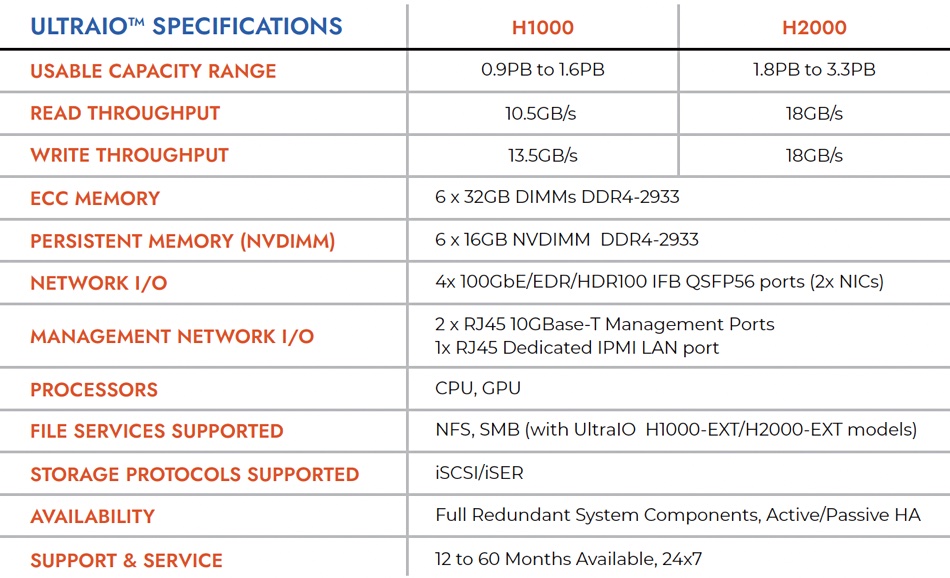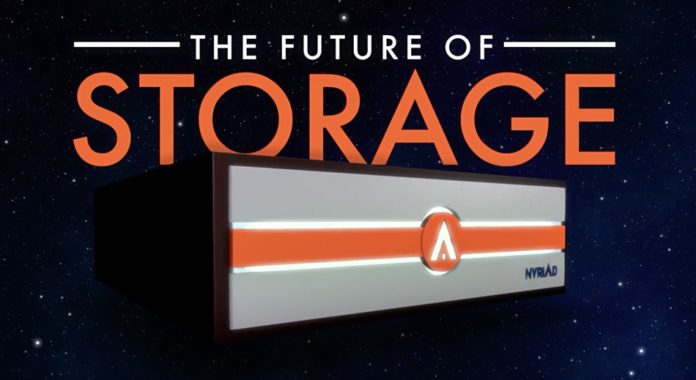Newcomer Nyriad has launched two SAN array systems with combined CPU+GPU controllers to provide fast recovery from drive failures and a maximum sustained IO rate of 18GB/sec for writes and reads.
The company uses 18TB disk drives with erasure coding and the IO workload is spread across all the drives to achieve the high IO rate. Nyriad says the arrays are good for data-intensive use cases such as HPC, media and entertainment, and backup and archive. Users will get consistent high performance without the long rebuild times and associated performance degradation that are common with today’s RAID-based storage systems, it says.
Nyriad CEO Derek Dicker said: “RAID has been the de facto standard for storage for more than three decades, but the demands of today’s data-intensive applications now far exceed its capabilities. With the UltraIO system, Nyriad built a new foundation for storage that addresses current problems and creates new opportunities for the future – without requiring organizations to make disruptive changes to their storage infrastructure.”
There are two H series systems, both with dual active-passive controllers, the H1000 and H2000, with 99.999 per cent data availability. They both use dual Intel Xeon CPUs in each of their two controllers (head nodes) and Nyriad plans to move to a single-processor design in both head nodes. On the GPU front they use dual Nvidia RTX A6000 GPUs in each of their two head nodes, again with a plan to move to a single GPU in each node.
The dual controllers feature dual HBAs, which are attached to drive enclosures via SAS4 cabling. The H1000 supports up to 102 disk drives and the H2000 supports up to 204 disk drives. The detailed specs are below:

The H Series are classified as block storage systems and customers can non-disruptively connect UltraIO as a POSIX Compliant Block Target into their existing infrastructure. File and object protocol support will be added in the future – the table above mentions SMB support with H1000-EXT and H2000-EXT models.
Customers can specify a number of parity drives, up to 20. An example was given of an H2000 system with 200 18TB drives configured at 20 parity. It can continuously write at 18GB/sec and also continuously read at 18GB/sec. If 20 of the 200 drives were to fail concurrently, it would continue to operate with just 5 per cent performance degradation.
When a drive fails, the system’s performance doesn’t decline noticeably and the failed drive doesn’t need urgent replacing, according to the company. Nyriad says the UltraIO OS utilizes all the drives for all the work all the time with intelligent data block placement mechanisms and use of a large persistent cache. It can utilize the entire drive array to provide write operations concurrently, placing data to optimize both writing and subsequent concurrent reading performance. It also does write deduplication when high-frequency block updates take place.
In general, though, the UltraIO systems do not do data reduction. A Nyriad spokesperson told us: “Our initial target market segments are HPC, media and entertainment, and backup, restore, and archive. These segments seem to value absolute performance first. In addition, their data tends not to benefit from data reduction techniques. If we discover that there is a demand for these techniques, the computational power we have will allow us to address it.”
The OS stores an erasure coding integrity hash with every block written. It then integrity checks each block as it is read and ensures it is correct. If not, it recreates it. We think that GPU processing power is used to do the hashing and integrity checks, which would overburden a dual-x86 controller design.
H Series systems can scale up within configuration limits and then scale out by adding more H Series arrays. Nyriad said the UltraIO system is designed to support multiple media types, including SSDs. It will make decisions about which media types it will support, and when, based on market demands.
There is an administration GUI, a RESTFul API, and a Secure Shell for operating storage and other services securely over a network.
Check out the H Series datasheet here. The system is sold exclusively through Nyriad’s channel and you can contact Nyriad to find out more.
StorONE
Nyriad competitor StorONE does fast RAID rebuilds. Its vRAID protection feature uses erasure coding and has data and parity metadata striped across drives. Its S1 software uses multiple disks for reading and writing data in parallel, and writes sequentially to the target drives. In a 48-drive system, if a drive fails, vRAID reads data from the surviving 47 drives simultaneously, calculating parity and then writing simultaneously to those remaining 47 drives. A failed 14TB disk was rebuilt in 1 hour and 45 minutes, and failed SSDs are rebuilt in single-digit minutes.








